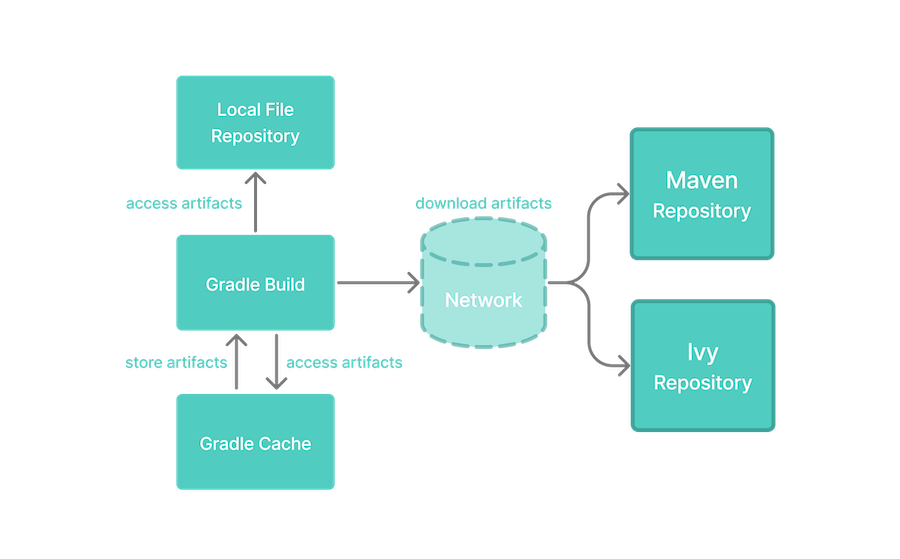Gradle's real achitecture
Gradle's real achitecture
satya - 7/17/2018, 9:30:06 AM
Gradle's real architecture
Gradle's real architecture
satya - 7/17/2018, 9:31:04 AM
Steep learning curve: critical look at Gradle as a build system
Steep learning curve: critical look at Gradle as a build system
satya - 7/17/2018, 9:36:53 AM
Gradle project, plugin and task interaction
Gradle project, plugin and task interaction
satya - 7/17/2018, 9:43:17 AM
There is no exposition of this on the web so far
may be in youtube videos
videos really slows down learning (for me)
How to projects, plugins, and tasks interact?
what is configured?
What is executed?
What is gradle's philosophy and architecture?
The how, that explains how it ticks?
By knowing what everything else derives meaning?
satya - 7/17/2018, 9:43:38 AM
perhaps understanding its plugins makes this clear
satya - 7/17/2018, 9:49:54 AM
What I grasped
Convention
Execution (via tasks) assuming convention
Configuring execution to (to describe dependencies or altering convention)
satya - 7/17/2018, 9:50:07 AM
Very early I warn
Very early I warn
satya - 7/17/2018, 9:59:56 AM
what are the basic entities of gradle
what are the basic entities of gradle
satya - 7/17/2018, 10:08:18 AM
Gradle topic
Tasks:Search On Web
Configurations:Search On Web
Dependencies:Search On Web
Artifacts:Search On Web
Repositories:Search On Web
satya - 7/17/2018, 10:50:15 AM
Gradle GMV syntax explanation
Gradle GMV syntax explanation
satya - 7/17/2018, 10:55:52 AM
Finally located a picture in gradle docs

satya - 7/17/2018, 10:57:45 AM
Another note on configuration
A build script developer can declare dependencies for different scopes e.g. just for compilation of source code or for executing tests. In Gradle, the scope of a dependency is called a configuration
satya - 7/17/2018, 10:58:51 AM
More on module dependency
If you declare a module dependency, Gradle looks for a module metadata file (.module, .pom or ivy.xml) in the repositories. If such a module metadata file exists, it is parsed and the artifacts of this module (e.g. hibernate-3.0.5.jar) as well as its dependencies (e.g. cglib) are downloaded. If no such module metadata file exists, Gradle may look, depending on the metadata sources definitions, for an artifact file called hibernate-3.0.5.jar directly. In Maven, a module can have one and only one artifact. In Gradle and Ivy, a module can have multiple artifacts. Each artifact can have a different set of dependencies.
satya - 7/17/2018, 11:03:12 AM
Gradle configurations compile runtime, where are these defined?
Gradle configurations compile runtime, where are these defined?
Search for: Gradle configurations compile runtime, where are these defined?
satya - 7/17/2018, 11:11:32 AM
For the java plugin these are documented here
satya - 7/17/2018, 11:15:03 AM
How can I add a local jar file as a gradle dependency?
How can I add a local jar file as a gradle dependency?
Search for: How can I add a local jar file as a gradle dependency?
satya - 7/18/2018, 8:22:32 AM
Here are how various dependencies are added
apply plugin: 'java'
//so that we can use 'compile', 'testCompile' for dependencies
dependencies {
//for dependencies found in artifact repositories you can use
//the group:name:version notation
compile 'commons-lang:commons-lang:2.6'
testCompile 'org.mockito:mockito:1.9.0-rc1'
//map-style notation:
compile group: 'com.google.code.guice', name: 'guice', version: '1.0'
//declaring arbitrary files as dependencies
compile files('hibernate.jar', 'libs/spring.jar')
//putting all jars from 'libs' onto compile classpath
compile fileTree('libs')
}
satya - 7/18/2018, 8:45:19 AM
Here is an interesting way of using project extensions
satya - 7/18/2018, 8:46:40 AM
Quick summary
Define a class with executable methods that can operate on any aspect of Gradle build
Register the class with Gradle as an extension
You can execute methods of that class as a closure whose delegate is that class instance
satya - 7/18/2018, 11:20:32 AM
Dependency object hierarchy
org.gradle.api.artifacts.ExternalDependency
isForce, setForce, version
org.gradle.api.artifacts.ModuleDependency
addArtifact, artifact, artifact, attributes,
exclude, getArtifacts, getAttributes,
getExcludeRules, getTargetConfiguration, isTransitive,
setTargetConfiguration, setTransitive
org.gradle.api.artifacts.Dependency
because, contentEquals, getGroup,
getName, getReason, getVersion
org.gradle.api.artifacts.ModuleVersionSelector
getGroup, getModule, getName,
getVersion, getVersionConstraint, matchesStrictly
satya - 7/18/2018, 11:24:03 AM
Type of dependencies are documented in DependencyHandler API
Type of dependencies are documented in DependencyHandler API
satya - 7/18/2018, 11:25:41 AM
Type of dependencies
External library
Other projects
Files
Other configurations
Gradle dependencies
Client module dependencies
satya - 7/18/2018, 11:32:14 AM
Here is how to work with files in Gradle
satya - 7/18/2018, 11:47:06 AM
Here is a chapter of a book on dependencies
satya - 7/18/2018, 12:13:31 PM
is classpath a gradle dependency configuration name?
is classpath a gradle dependency configuration name?
Search for: is classpath a gradle dependency configuration name?
satya - 7/18/2018, 12:24:06 PM
Here is a - slightly - better explanation of "classpath" as a configuration
Here is a - slightly - better explanation of "classpath" as a configuration